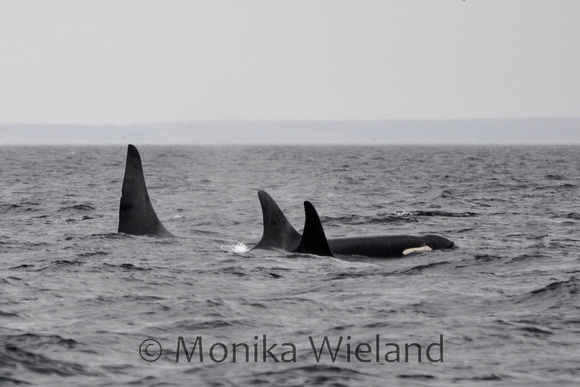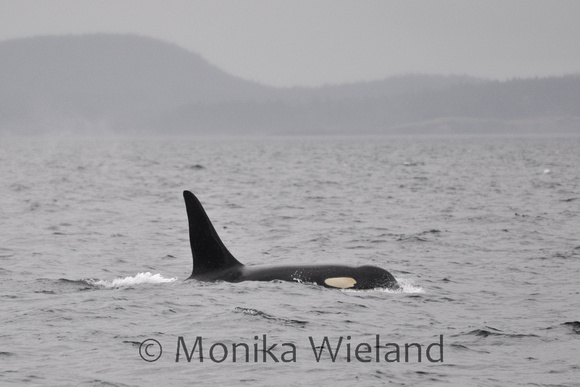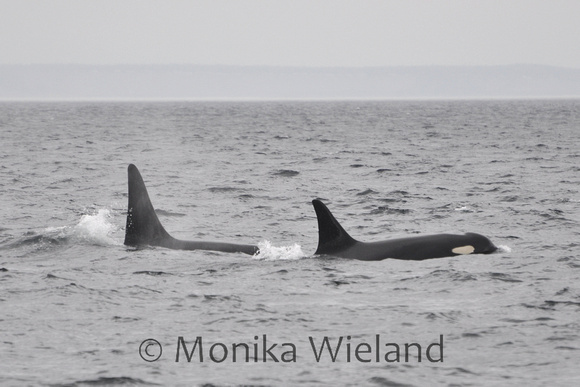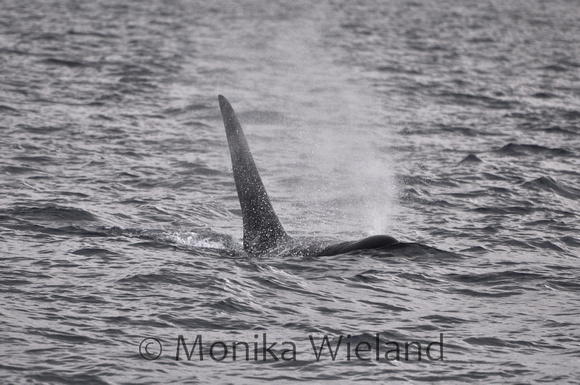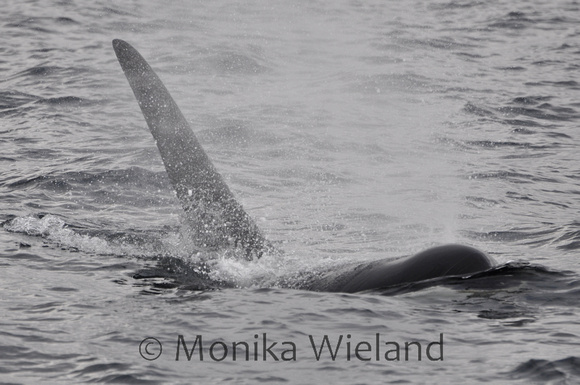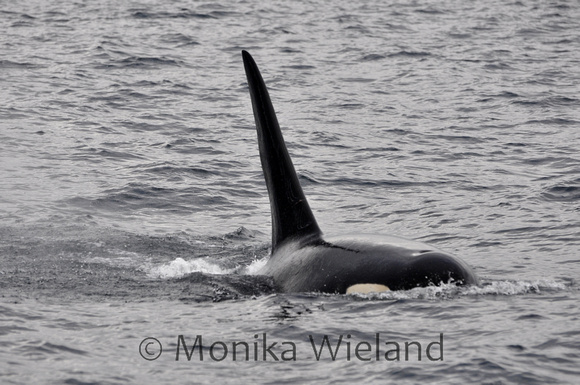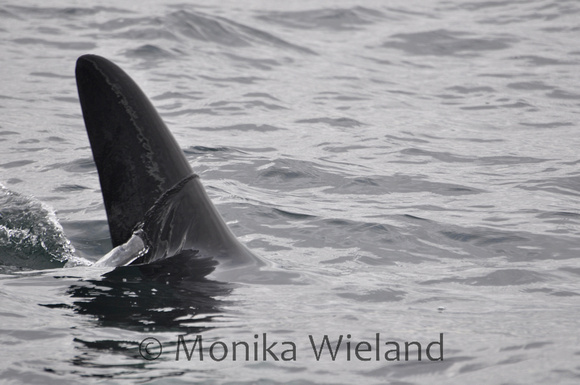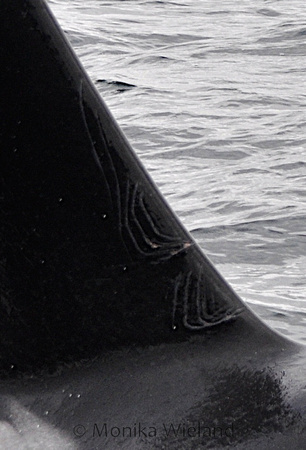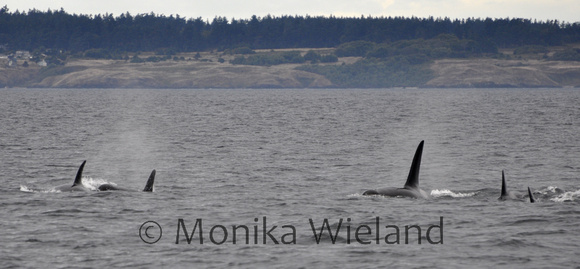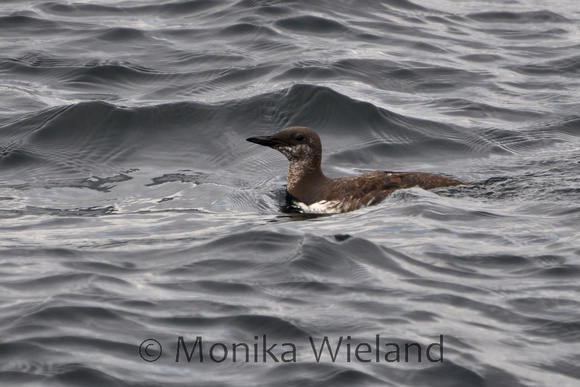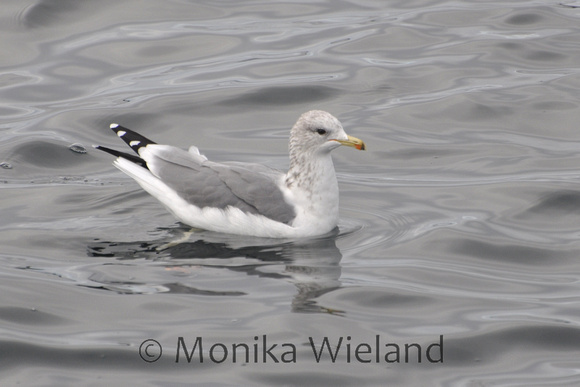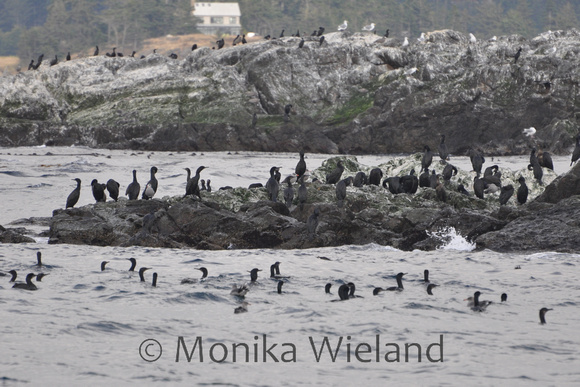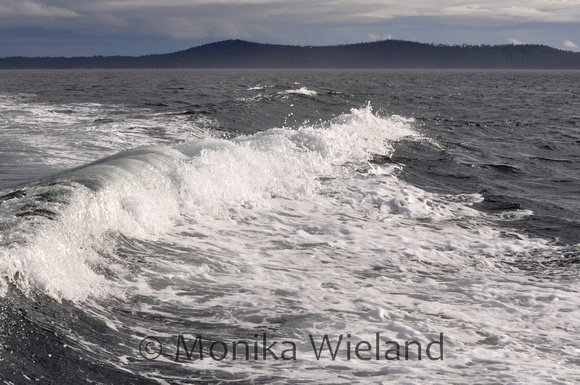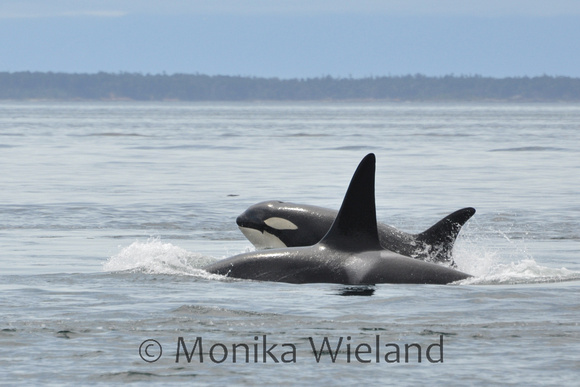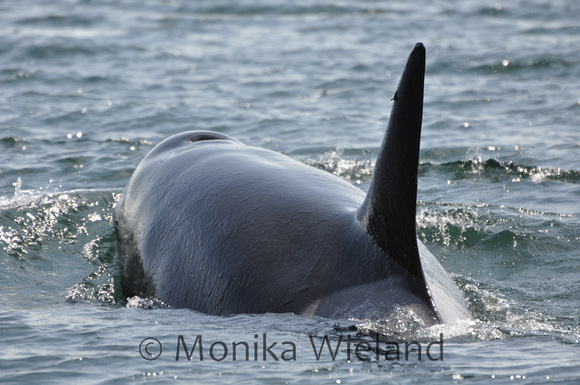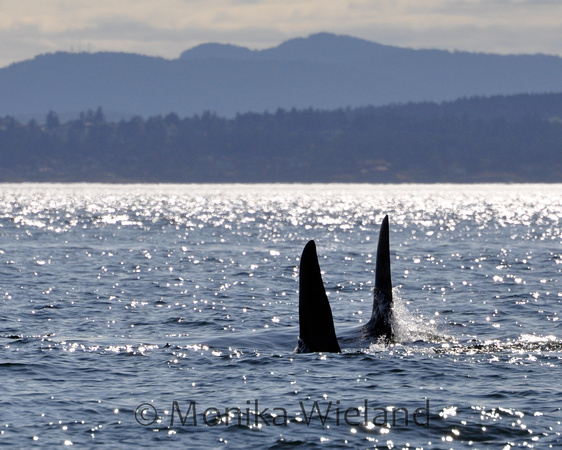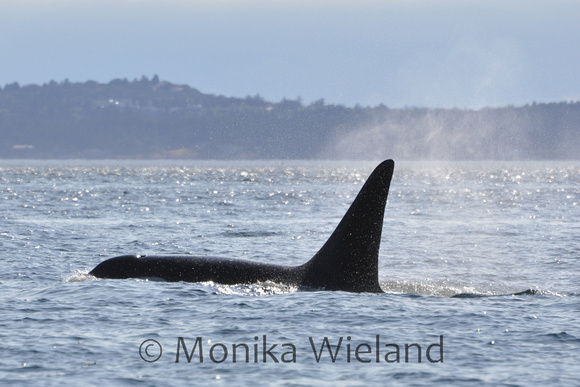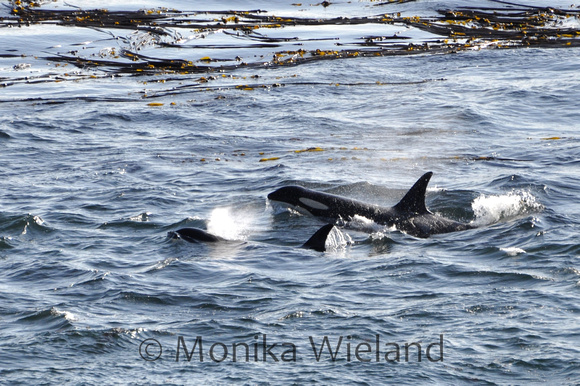Every year I write a blog post to honor and remember the Southern Residents who passed away during the previous year. As I was preparing for this post, I was flipping through my ID guides, looking at the family groups of the whales we've lost. As I did this, it struck me just how many elder whales have died in recent years. While no longer reproductive, older female whales likely play an extremely important role in Southern Resident Killer whale society, both as leaders and carriers of cultural information. Both last year and this year we have lost three females born before 1970. J2 Granny and L25 Ocean Sun are now the only living whales that were adults when photo ID studies began in the early 1970s.
________________________________________
L26 Baba was last seen in March during NOAA's winter research cruise. She looked very emaciated and hence researchers were not surprised when she didn't show up in inland waters with the rest of L-Pod in early June. She was estimated to be 57. Baba had four known offspring, one of which still survives: her 20 year-old daughter L90 Ballena. She was also the mother of L60 Rascal, L52 Salish, and L71 Hugo, who all preceded her in death. Baba also has a living grandson, 18 year-old L92 Crewser. The three of them - Baba, Ballena, and Crewser - were regularly seen traveling together.
 |
| L26 Baba with her grandson L92 Crewser in August 2012 |
Baba had one of the most distinctive saddle patches of all the Southern Residents, making her one of the easiest whales to learn to identify. Her slender dorsal fin with a small notch in the top also helped distinguish her.
One of my most memorable encounters with Baba and her family was in July of 2009. I was working a double trip day on the Western Prince and it was one of those days where first thing in the morning we had no whale reports, but by the afternoon we had a superpod on the west side of San Juan Island. On our second trip of the day we met up with members of K- and L-Pods off of South Beach, and then followed some L-Pod whales INTO Cattle Pass. Usually they stay out in the larger strait, but on this day they seemingly let the currents push them into the pass, where they were doing a lot of rolling around on the surface, playing in the strong waters. Just before it was time to leave, three whales approached us on the port side. Of course, my camera battery had died earlier in the trip, but based on photos a passenger shared with me later on I determined they were Baba, Crewser, and Ballena. Crewser was swimming upside down, never breaking the water's surface, but the white on his belly as well as from the underside of his tail flukes was clearly visible. Baba and Ballena were also close enough to be visible underwater, one of them turning on her side and looking up at us as they cruised the length of the both. I squinted into the sun as they surfaced right off the front of the boat and made their way back out of Cattle Pass.
 |
| L26 Baba in 2010 |
________________________________________
L2 Grace went missing at an estimated age of 52. As far as I know, she wasn't seen at all in 2013. She was the matriarch of a rather independent group of L-Pod whales known for doing their own thing. Often they wouldn't visit inland waters nearly as much as most of the rest of L-Pod during the summer months, and sometimes they would be traveling on their own with no other Southern Residents. The odd, independent nature of the L2s carried over into Grace's grandson L98 Luna, who ended up on his own in Nootka Sound from 2001-2006. Grace had four known offspring: L39 Orcan, L67 Splash, L78 Gaia, and L88 Wavewalker. The only surviving member of her family group is now her 20 year-old son L88 Wavewalker; this matriline will die out with him, as it has no further reproductive females.
 |
| L2 Grace with her sons L78 Gaia (left) and L88 Wavewalker (right) in 2008 |
Like Baba, Grace had a very distinct open saddle patch - in fact, they were two of a kind in that sense. Grace also had three small notches on her dorsal fin, one of which was distinct enough to help ID her in photos even when her saddle patch wasn't clearly visible. When you saw Grace up close, she was a noticeably small whale.
The first time I realized Grace was so small was in September of 2007 when I was out on a NOAA research boat off the south end of San Juan Island. We were paralleling alongside Grace, and since we were operating under a research permit we were allowed to be much closer to the whales than I ever was on a whale watch boat; sometimes the whales do come close to whale watch boats, but we would never be under power when they were, so it was a very unique experience to be moving along with Grace as she swam at such a close distance. I could see her whole body underwater, and what struck me most was how short she was. I also remember how effortlessly she seemed to propel herself through the water. All of a sudden she turned and disappeared, so quickly that I didn't even see how she executed the maneuver.
 |
| L2 Grace in 2009 |
With Grace's death, I was worried about the prospects for her orphaned son Wavewalker. Among resident killer whales, it seems like males need a female to be attached to or their prospects for survival go down. Luckily, throughout the summer of 2013 Wavewalker seemed to have linked up with L54 Ino and her family. They're another somewhat "rogue" matriline, so I hope he continues to fit in just fine.
________________________________________
It might be expected that the older part of the population will eventually die out, but what we don't expect is to be losing young adult males that should be in their prime. This summer, 24 year-old male L79 Skana was the latest in a disturbing trend of breeding-age males dying in this population. We've lost four other whales in this age/sex class in the last three years.
.jpg) |
| L79 Skana in 2010 |
Skana's family was doing something unusual this summer: for the first time, they were for days on end the only whales here. He, his mother L22 Spirit, and his younger brother L89 Solstice were patrolling the west side of San Juan Island on their own in July, much the way they usually do with the rest of the L12 subgroup in the summer months, but this time the rest of the L12s weren't here. Perhaps it was an indicator that something was wrong, because Skana was last seen in mid-July, and didn't return with his family group when they were next seen in August.
In addition to his brother Solstice, Skana also had a sister L75 Panda who preceded him in death. For all the time I've known them, however, it's been "Spirit and the boys", with Skana being much more of a mama's boy than Solstice, rarely being apart from her. I always thought he was an interesting whale to ID because his right side saddle patch looked like J27 Blackberry and his left side saddle patch looked like J26 Mike, two other males about his age.
 |
| L79 Skana - a real mama's boy - next to mother L22 Spirit in 2006 |
My last "good" (i.e. close) whale encounter in 2011 was with Skana. His mother, of course, wasn't too far away, but he was the one that came right up to us on that gray September day aboard the Western Prince. In my photos I can clearly see the small nick in his dorsal fin, as well as a whole series of fresh rake marks. This is my favorite shot in the sequence, however, of the tip of his dorsal fin just starting to rise through the water's surface:
 |
| Skana just beginning to surface in 2011 |
He was a photogenic whale - I had a hard time selecting pictures to include here!
________________________________________
When I started thinking about this post a month ago, I thought these three L-Pod whales would be the only ones I would have to write about. I'm saddened to have to include one more: J8 Spieden.
It's never a happy moment to learn that one of our Southern Residents is "missing", which 99 times out of 100 also means dead. On October 16th I was excited to hear that J-Pod was coming in, but that mood was tempered when I heard that Spieden wasn't with them. I guess she was last seen on September 19th. This one hits me especially hard, however, as most J-Pod deaths do, because I know these whales even better and have spent more time with them than with Ks and Ls.
Spieden, who lived to an estimated age of 80, was a J-Pod icon, right up there with J1 Ruffles and J2 Granny, whom she often traveled with. Assumed to be a post-reproductive female from when studies began in the 1970s, she was probable mother of J4 Mama and also had a strong association with adult male J6 Ralph, possibly her brother. She was easily identified not only by her stubby dorsal fin which starting in 2005 had a small notch at the base, but by her distinct wheeze when she breathed. With most whales, you can hear their exhalation, but with Spieden, you could also always hear her noisy inhalation. I always said about Spieden, "She's the only whale I can identify in the fog", because you didn't have to see her to know it was her. She leaves behind J19 Shachi, her possible granddaughter, and J41 Eclipse, her possible great granddaughter; whether or not these whales were related by descent, they always spent a lot of time together, indicating they were probably family.
 |
| The short, stubby dorsal fin of J8 Spieden, seen here right off the rocks at Lime Kiln in 2005 |
I have so many fond memories of encounters with Spieden, but when I think of her what really stands out is how much of a care-taking whale she was. When another whale needed a mother figure, it seems like she was always there. She would often babysit the offspring of her daughter J4 Mama, particularly taking care of the older whales when Mama had a new calf in tow. This tendency of taking care of older juveniles who may be getting less attention from a new mom extended beyond just her family: she took J33 Keet under her wing when J36 Alki was born, and she looked after J32 Rhapsody when she became an orphan. Most recently, since 2010, she was known for being associated with the "lost" male L87 Onyx, who has been attaching to various older females after the death of his mother.
 |
| Caretaker Spieden, seen here with K42 Kelp in 2008. This is a cropped version of one of my most popular photos, "You'll Never Swim Alone" (click to see full image) |
In addition to being a community-wide mother figure, I think of Spieden for her strong friendship with J2 Granny. Often the two of them would be traveling together in the lead, far ahead of any other whales. I can only imagine what knowledge those two elder females had between them, and what sort of stories they could tell.
 |
| J8 Spieden (left) with J2 Granny in September 2012 |
________________________________________
To end these Day of the Dead posts on a brighter note, I've been summarizing at the end the new births to celebrate that have occurred during the preceding year. Unfortunately, this year, I can't even do that. Amazingly, there have been no live calves born in the last twelve months - not a good sign. A dead male calf washed up on Dungeness Spit in early January, and through genetics it was determined to belong to J28 Polaris; it would have been her second calf. It's unusual for a dead Southern Resident to wash ashore, so we can only imagine if other calves have been lost in this same time period. If whales are miscarrying, birthing stillborns, or losing calves very early on any sort of regular basis, that is a scary fact. The investment into even a single calf is immense: 17 months of gestation, and then 1-2 years of nursing. At best, whales will only give birth once every 4-5 years if they're rearing healthy young. We can only hope that things will turn around next year, there will be more births, and we will have more to celebrate again. With this years losses, the current Southern Resident population count is 80 whales.









